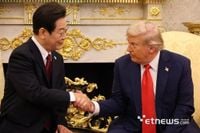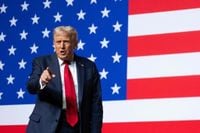In a swirl of diplomatic anticipation and uncertainty, the Trump administration’s plans for the upcoming Asia-Pacific Economic Cooperation (APEC) summit have become the subject of intense international scrutiny. With the summit’s opening ceremony in Gyeongju, South Korea, set for October 31, 2025, the world is watching as the United States weighs its participation and the possibility of President Donald Trump making a brief, whirlwind visit to the Korean Peninsula.
According to multiple reports from Yonhap News, Busan.com, and iNews24, President Trump is considering a visit to South Korea on October 29—two days before the official start of the APEC summit. This potential stopover would follow a tightly packed itinerary: first, attending the ASEAN (Association of Southeast Asian Nations) summit in Kuala Lumpur from September 26 to 28; then, a likely visit to Japan between October 27 and 29, where a summit with Japan’s new prime minister is expected to take place.
Despite the meticulous diplomatic choreography, the Trump administration has yet to finalize its decision on whether the president will attend the main APEC event. Internal disagreements and complex political considerations have kept the decision in flux, with officials on both sides of the Pacific maintaining a cautious posture. As one South Korean government official told iNews24, “We are in close communication with the U.S. side regarding President Trump’s visit for APEC, as well as the details of a potential U.S.-South Korea summit.”
The uncertainty has sparked speculation about the nature—and even the brevity—of Trump’s possible visit. Some diplomatic observers suggest that the president could make a “day trip” to South Korea, arriving on the 29th and departing the same day, without staying for the APEC opening ceremony. The reasoning? President Trump’s Asia tour is already packed, and dedicating additional days to the summit may not be feasible given other pressing commitments.
“I understand that President Trump will arrive on the 29th and visit Gyeongju,” a ruling party official told Ajunews. “But the overall schedule has not yet been finalized and is still being coordinated between the U.S. and South Korea.” The official added that, as of now, it’s unclear when Trump would depart, leaving the possibility open for a rapid turnaround.
Further complicating matters is the ongoing uncertainty surrounding a possible U.S.-China summit. The timing of a meeting between President Trump and Chinese President Xi Jinping remains a significant variable, with both leaders’ schedules potentially influencing each other. As Scott Besant, the U.S. Treasury Secretary, emphasized in a recent interview with CNBC, “The most important thing is that at the end of this month in Korea, President Trump and Chinese President Xi Jinping will hold a summit.” The anticipation around this meeting underscores its perceived importance, particularly amid a protracted U.S.-China negotiation deadlock.
Adding to the intrigue, the possibility of a Trump-Kim summit—another high-profile diplomatic encounter—has been floated, though officials downplay its likelihood. “At this point, it doesn’t seem likely that the U.S. and North Korean leaders will meet,” a government source told Ajunews. “If President Trump is only making a brief visit to South Korea before the APEC main event, the chances of a successful summit with Kim Jong-un are even lower.”
While the world waits for clarity, the Trump administration’s internal debates highlight the sensitive nature of U.S. participation in the APEC summit. According to Busan.com, the decision is being closely monitored internationally, with allies and rivals alike eager to gauge America’s diplomatic priorities in the region. The administration is reportedly reviewing not just the political optics, but also the security and logistical aspects of any potential visit.
Political observers note that the uncertainty reflects broader challenges facing U.S. foreign policy in Asia. The region’s shifting alliances and the high stakes of U.S.-China relations have made every move—and every moment of indecision—ripe for analysis. For South Korea, hosting the APEC summit is a major opportunity, but also a diplomatic balancing act, as it navigates the interests of both Washington and Beijing.
Meanwhile, the Japanese government is also preparing for a possible summit with President Trump, with Yomiuri Shimbun reporting that a meeting with Japan’s new prime minister is being coordinated for October 28. This stop, sandwiched between the ASEAN summit and the potential visit to South Korea, reflects the administration’s effort to shore up key alliances amid a period of global uncertainty.
As the clock ticks toward October 29, the final decision on U.S. participation in the APEC summit is expected to come down to the wire. Both American and South Korean officials have acknowledged the possibility of a last-minute announcement, with the U.S. reportedly keeping its options open until the very end. “There are still variables, such as the timing of the U.S.-China summit, so President Trump’s schedule remains fluid,” a South Korean official explained to Ajunews.
For now, the only certainty is uncertainty. The Trump administration is preparing for every scenario, from a full-fledged diplomatic blitz to a fleeting appearance that leaves more questions than answers. The stakes, however, are clear: with U.S.-China relations at a crossroads and regional alliances in flux, the world will be watching closely to see whether President Trump’s visit to South Korea marks a turning point—or simply another twist—in the ongoing saga of Asia-Pacific diplomacy.
Whatever the outcome, the events of late October 2025 promise to shape the trajectory of U.S. engagement in the region, with ramifications that could echo far beyond the summit halls of Gyeongju.

